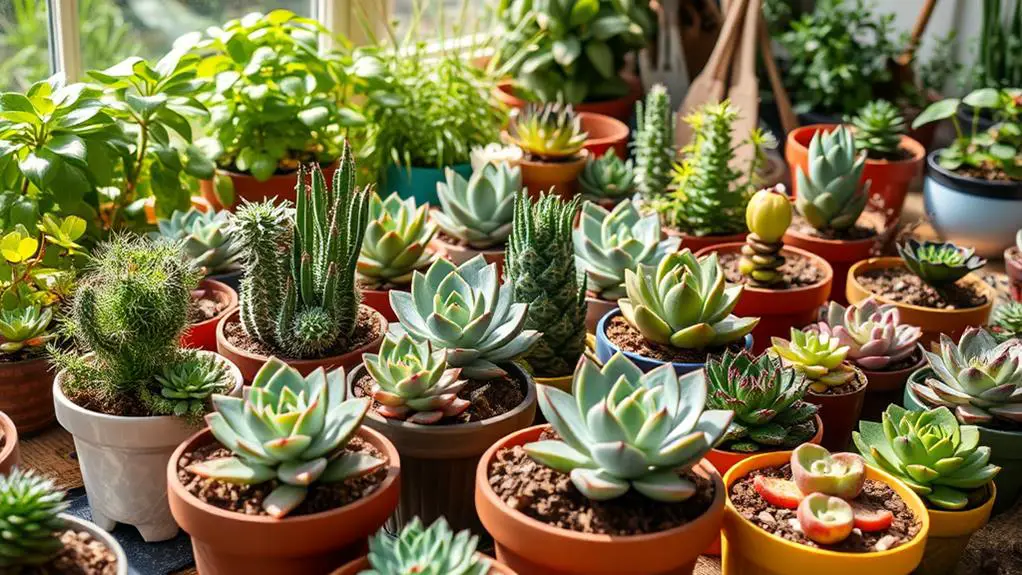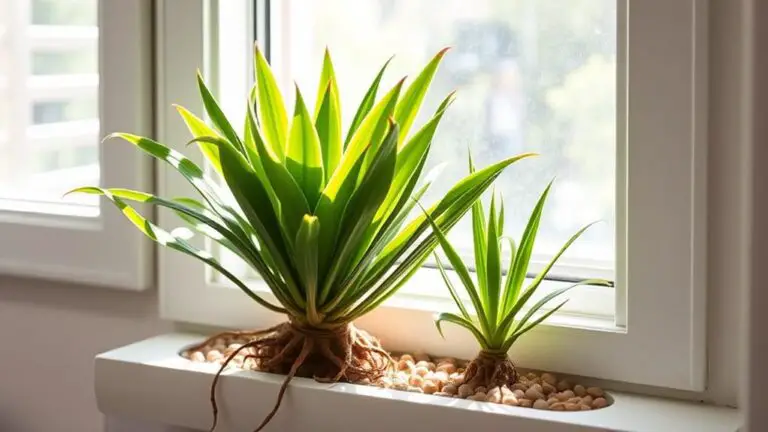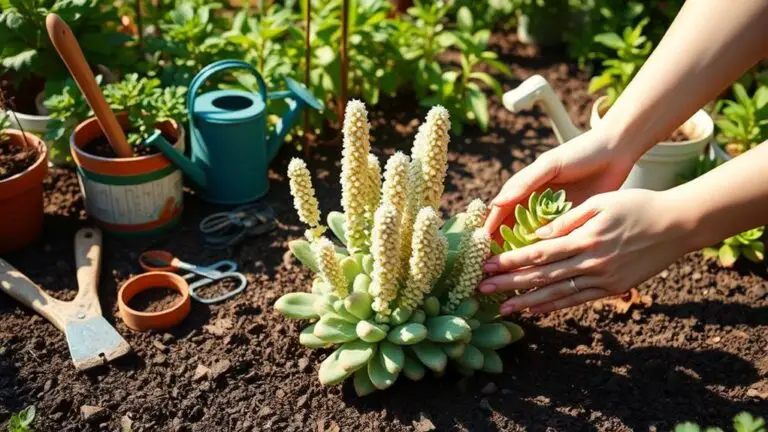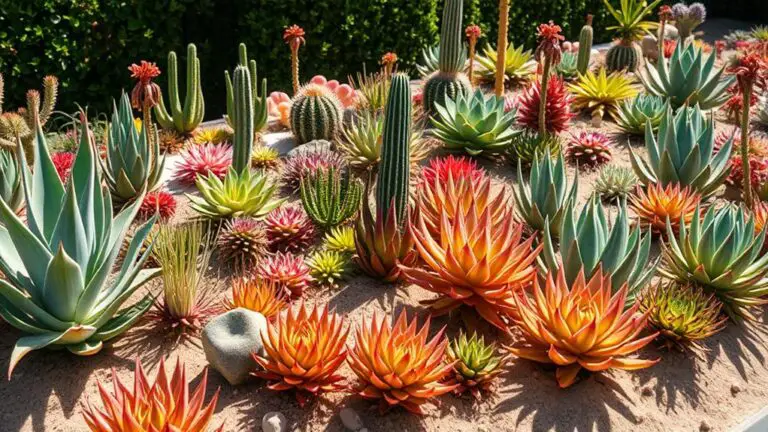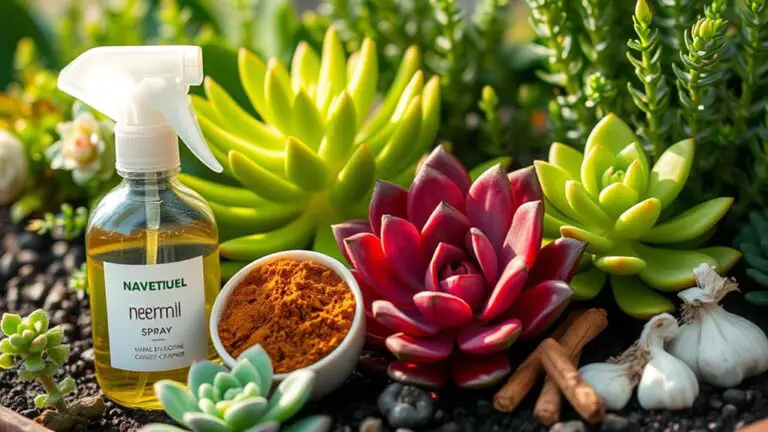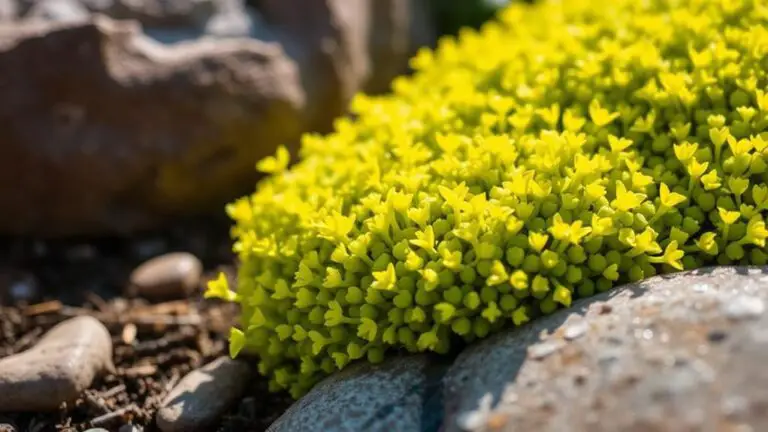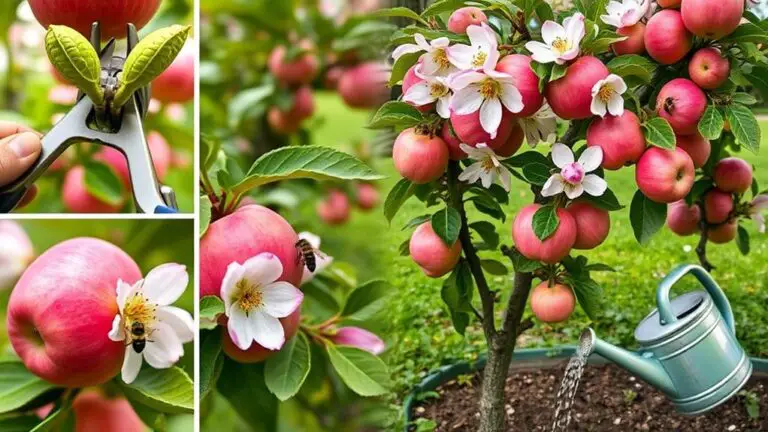10 Essential Tips for Thriving Succulents
When it comes to succulents, ensuring they thrive involves more than just occasional watering. You'll need to take into account their need for bright, indirect sunlight and the importance of letting the soil dry out completely between waterings. Choosing the right soil and containers can make a significant difference, and don't forget about the role of seasonal adjustments in their care. Monitoring for pests and knowing how to fertilize correctly are also essential steps. Curious about how to balance all these elements for ideal growth? Let's explore how you can master the art of succulent care.
Light Requirements
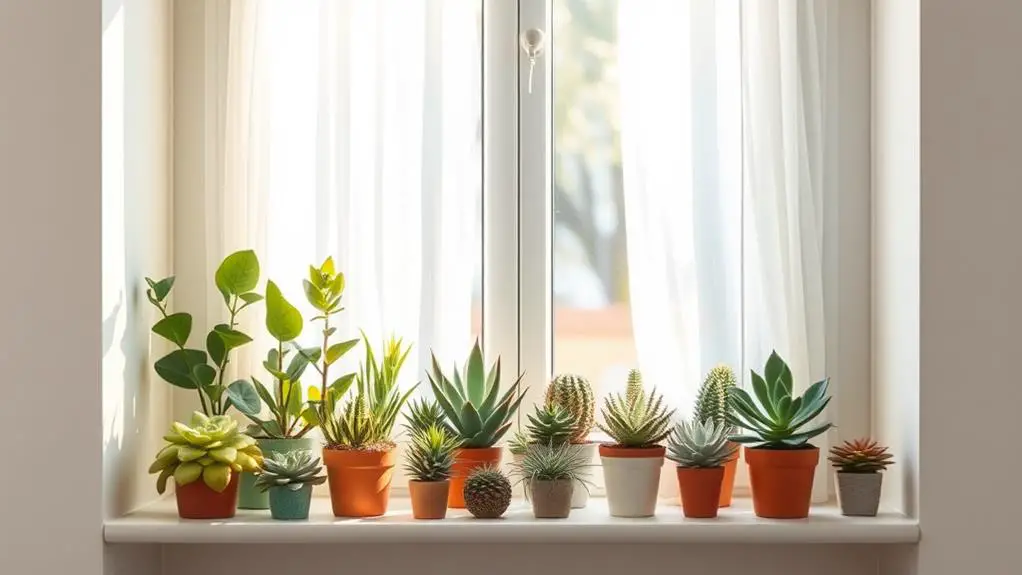
To keep your succulents thriving, ensuring they get the right amount of light is essential. Succulents need approximately six hours of sunlight daily. Most varieties can't thrive in full shade, so it's important to find a spot with bright, indirect sunlight. You can use sheer curtains to provide the necessary shade without blocking too much light.
If your succulents start leaning towards the light, it's a sign they're not getting enough sunlight. Rotating your plants weekly helps them grow evenly.
Remember, too much direct sunlight can burn their leaves. If you notice burnt leaves, consider using supplemental grow lights, especially in low-light conditions.
Creating a microclimate by grouping your plants can help them get adequate light and humidity. This environment supports their growth and helps prevent issues like waterlogged soil.
Keeping a balanced light exposure is key to healthy succulents.
Watering Practices
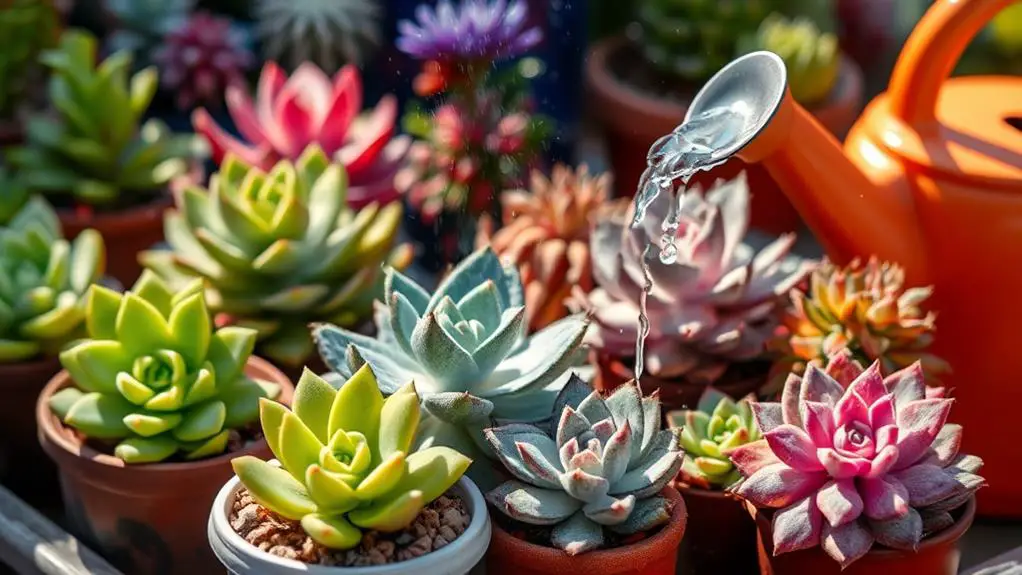
While light is essential for succulent health, watering practices play an equally important role. To keep your succulents thriving, avoid overwatering, which is a common mistake that can lead to root rot. Water your succulents only when the top 1.25 inches of soil is completely dry. Implement the "soak and dry" method by thoroughly soaking the soil until water drains from the bottom and allowing it to dry completely between waterings.
During the growing season, typically in spring and summer, succulents may need watering every week or two. In winter, when succulents are dormant, they require considerably less water. Always use room temperature water to prevent shocking the plants. Adjust your watering frequency based on seasonal changes and the size of the pot since smaller pots dry out faster than larger ones.
Here's a quick reference to help you manage your watering practices:
| Season | Watering Frequency |
|---|---|
| Spring/Summer | Every 1-2 weeks |
| Winter | Considerably less |
| Pot Size | Drying Speed |
| Small | Faster |
| Large | Slower |
Monitor soil moisture levels frequently to guarantee your succulents are getting the right amount of water. Remember, well-drained soil and good drainage are key to preventing overwatering. Your succulents will thank you by staying healthy and happy!
Soil and Container Selection
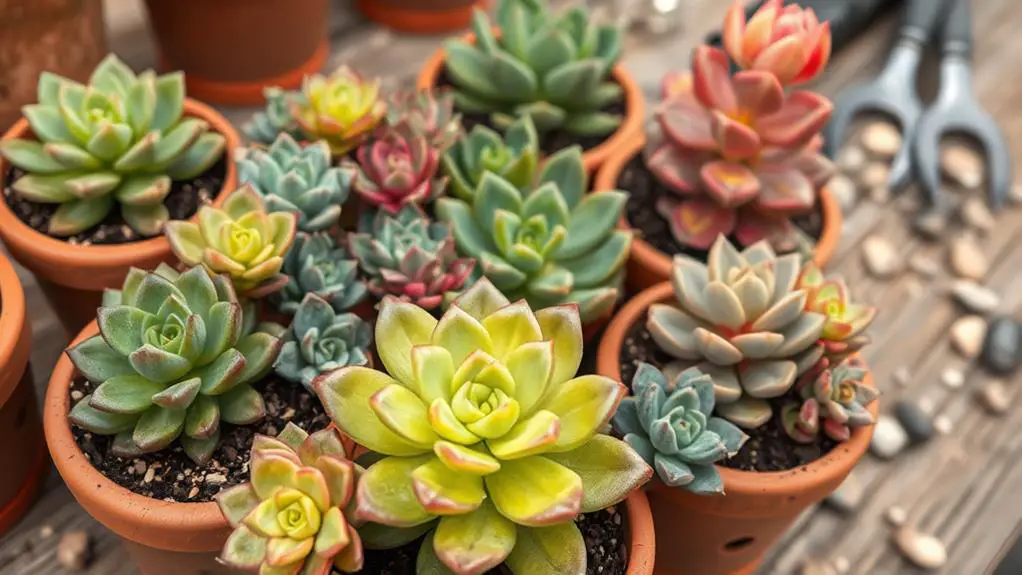
When choosing soil and containers for your succulents, it's key to use well-draining soil, like a mix of potting soil, sand, and perlite.
Make sure your pots have drainage holes to let excess water escape, which prevents root rot.
Terra-cotta pots work best because they promote evaporation, helping to avoid overwatering issues.
Choose Proper Containers
Selecting the right containers and soil mix is essential for the health of your succulents. First, choose containers with drainage holes to prevent waterlogging and root rot. This is important because succulents hate sitting in excess water. Adding to that, terra-cotta pots are excellent for beginners. Their porous nature allows for better evaporation and air circulation, promoting healthier roots.
When it comes to soil, use a well-draining soil mix specifically formulated for succulents. These mixes usually incorporate components like sand, pumice, or perlite, enhancing drainage and reducing the risk of overwatering. Overwatering is a common mistake that can lead to bacterial infections and root rot, so a good soil mix is essential.
Avoid plastic pots as they retain moisture, which can be harmful to your succulents. Repotting your succulents every 1-2 years is also beneficial. It helps refresh the soil, preventing salt buildup and ensuring your plants get the nutrients they need for healthy growth.
Here's a quick comparison:
| Container Type | Pros | Cons |
|---|---|---|
| Terra-cotta | Good drainage, air circulation | Can dry out quickly |
| Plastic | Lightweight, inexpensive | Retains moisture, risk of overwatering |
| Ceramic | Attractive designs, durable | Can be heavy, may lack drainage holes |
| Metal | Modern look | Can overheat in sun, not breathable |
| Wooden | Natural look, insulating | May rot over time, needs lining |
Optimize Soil Mix**
Optimizing your soil mix is vital for healthy succulents. Succulents need a well-draining soil mix to thrive, as they're prone to root rot if the soil retains too much moisture. Standard potting soil isn't ideal because it holds onto water. Instead, you can use a cactus mix or create your own by combining potting soil with sand and perlite. This combination promotes aeration and helps control moisture.
To guarantee your succulents stay healthy, follow these tips:
- Choose the Right Soil Mix: A well-draining mix is essential. Combine one part potting soil, one part sand, and one part perlite or pumice. This will help your succulents get the right balance of moisture and air.
- Select Pots with Drainage Holes: Always use pots with drainage holes to prevent water from accumulating at the bottom. Terra-cotta pots are a great choice for beginners because they're porous and help excess moisture evaporate.
- Repot Regularly: Repot your succulents every 1-2 years to refresh the soil and reduce salt buildup. This keeps the soil healthy and your plants happy.
Fertilizing Practices
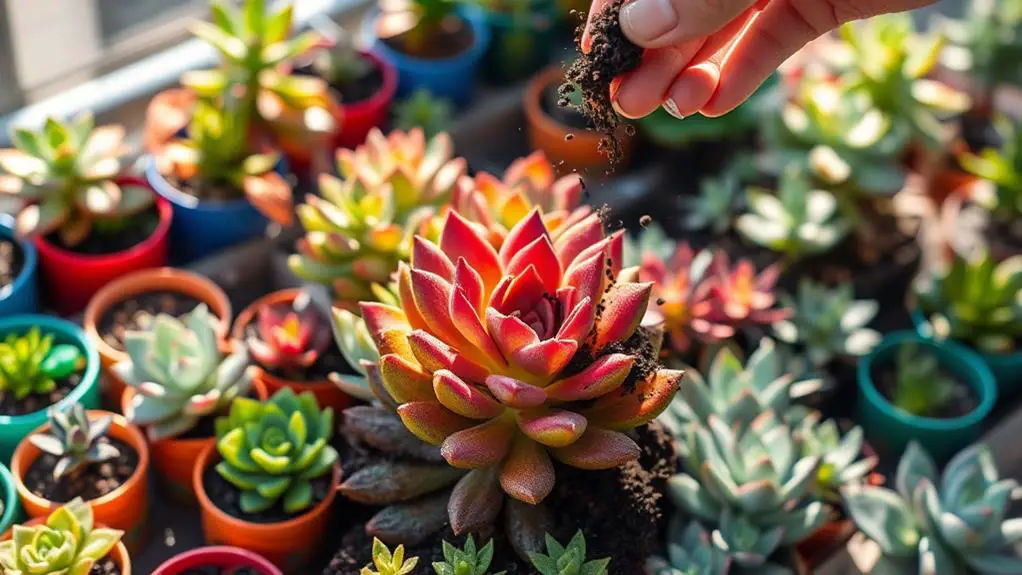
To keep your succulents thriving, fertilizing during their active growth season is essential. This period typically runs from spring to fall. Use a diluted balanced fertilizer, like a 10-10-10 formulation, at half strength. This guarantees your plants receive the right nutrients without risking over-fertilization. Light feedings once a month are perfect. Avoid fertilizing during winter dormancy, as succulents don't need nutrients then.
Here's a quick guide:
| Season | Fertilizer Type | Frequency |
|---|---|---|
| Spring | Balanced (10-10-10) | Once a month |
| Summer | Balanced (10-10-10) | Once a month |
| Fall | Balanced (10-10-10) | Once a month |
| Winter | None | None |
Over-fertilization can harm your succulents, so monitor plant response closely. If you notice any signs of stress, adjust your fertilizing practices. You might also want to try a cactus-specific fertilizer, which provides tailored nutrients that support succulent health and growth.
Always apply fertilizer to moist soil to prevent root burn and promote better nutrient absorption. By following these simple fertilizing guidelines, your succulents will flourish beautifully, rewarding you with their vibrant, healthy appearance.
Pest Management
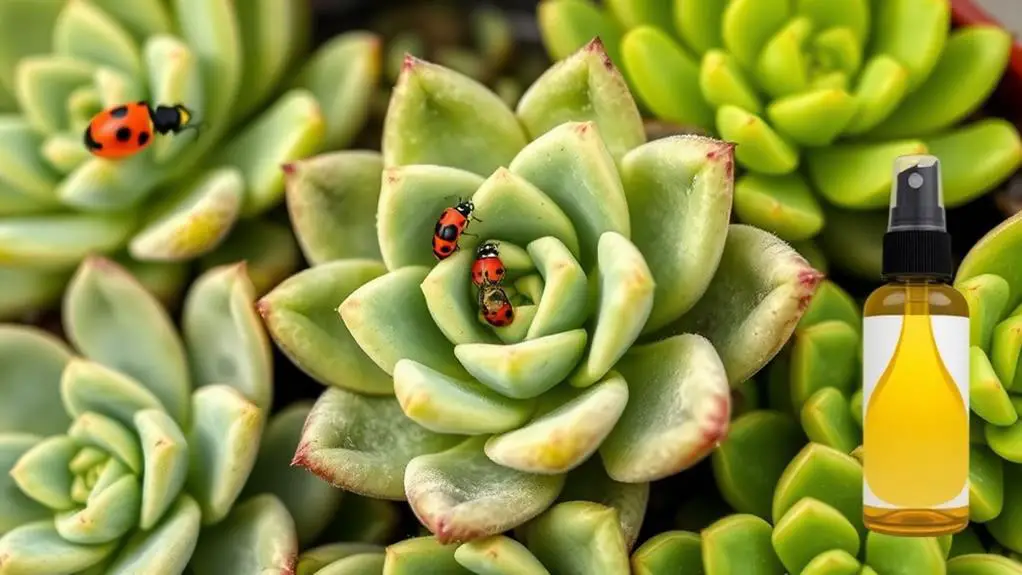
To keep your succulents healthy, regularly inspect them for pests like mealybugs, aphids, and spider mites.
Catching these bugs early makes treatment easier, and natural remedies like neem oil or insecticidal soap can be very effective.
Also, remember to keep your plant area clean and consider encouraging natural predators, like ladybugs, to help control pests.
Regular Pest Inspections
Anyone who loves succulents knows that regular pest inspections are essential to keeping these hardy plants healthy.
Frequently inspecting your succulents for pests like mealybugs, aphids, and spider mites can help you catch infestations early and control them before they cause significant damage.
Here's how you can keep your plants safe:
- Inspect your plants often: Look closely at your succulents at least once a week. Mealybugs are easy to spot because of their white, fuzzy appearance. Check for spider mites by looking for fine webs and any rapid damage to the leaves.
- Isolate infested plants: If you find any pests, immediately move the affected plant away from your healthy ones. This helps prevent the pests from spreading and gives you a better chance to control the situation.
- Maintain cleanliness: Keep the area around your succulents clean and tidy. Remove dead leaves and debris that could harbor pests.
Consider encouraging natural predators like ladybugs in outdoor settings to assist with pest control.
Effective Natural Remedies
While regular pest inspections are important, knowing how to address the issue naturally when pests appear is equally vital. When you spot pests like mealybugs or aphids on your succulents, don't panic. There are several effective natural remedies to manage these pesky invaders and keep your plants healthy.
One tried-and-true method is using neem oil. It's great for treating mealybug infestations. Just dilute it according to the instructions and apply it to the affected areas. Another simple technique is blasting aphids off your succulents with high-pressure water. This method doesn't require any chemicals, making it a safe and organic means of pest control.
Keeping your growing environment clean is also essential. Remove any debris around your plants to deter pest infestations. Additionally, if you're growing succulents outdoors, consider encouraging natural predators like ladybugs. They can help keep pest populations in check without needing any intervention from you.
Here's a quick reference guide:
| Problem | Natural Remedy |
|---|---|
| Mealybugs | Neem oil |
| Aphids | High-pressure water blasts |
| General pests | Clean environment, ladybugs |
Temperature and Humidity
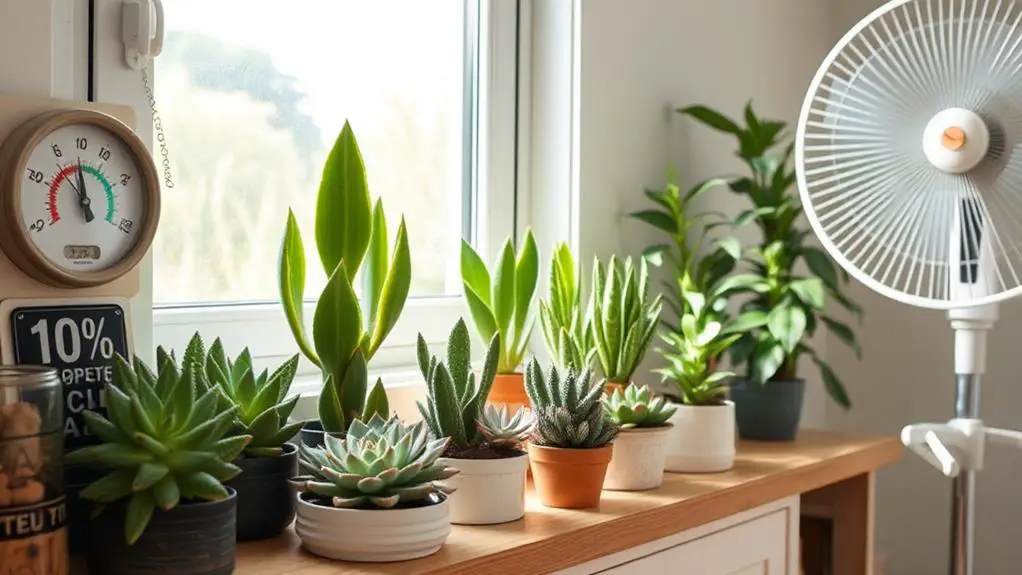
Ever wondered what makes succulents so resilient yet so picky about their environment? It all comes down to temperature and humidity.
Succulents thrive in temperatures ranging from 60°F to 80°F (15°C – 27°C). They need to be protected from frost, as many varieties aren't frost-tolerant. Keeping an eye on the weather helps guarantee your succulents' ideal growth.
Humidity plays a huge role in your succulents' health too. These plants prefer dry air, so maintaining low humidity is essential. Make sure to keep them away from heating vents or air conditioning units, which can create fluctuating temperatures that stress your plants. Consistency is key!
To help your succulents flourish, follow these three tips:
- Monitor Temperature: Keep it between 60°F and 80°F, and avoid temperatures below 40°F (4°C), which can damage your plants.
- Maintain Dry Air: Guarantee low humidity by keeping your succulents away from humid areas and vents.
- Prepare for Frost: Dry the soil before a cold snap to enhance survival chances, as excess moisture can worsen frost damage.
Following these steps will give your succulents the stable environment they need to thrive. Happy gardening!
Propagation Methods
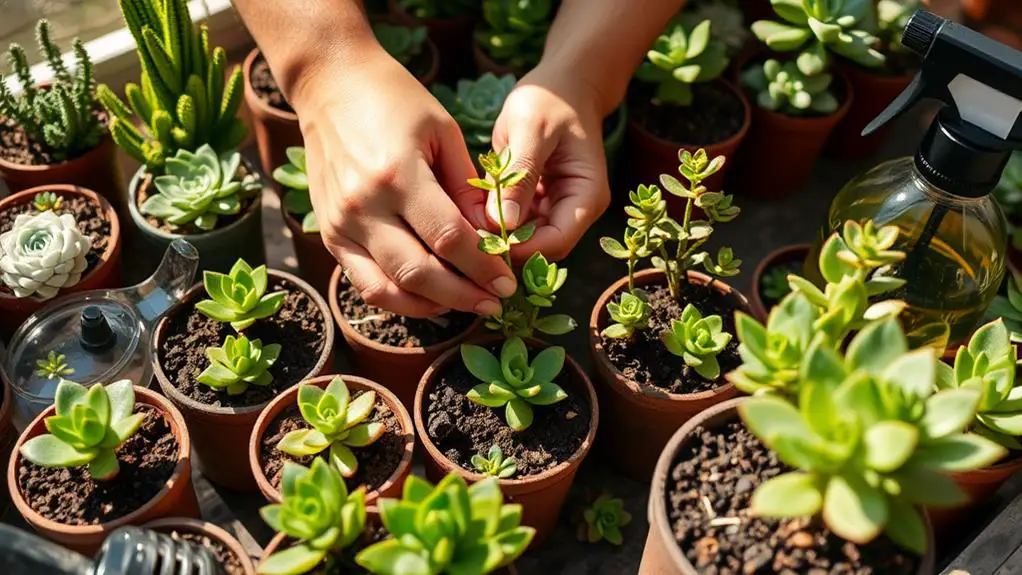
Now that you've got a handle on keeping your succulents comfortable with the right temperature and humidity, let's explore how you can expand your collection through propagation.
One of the most popular propagation methods is using leaf or stem cuttings. Begin by cutting a healthy leaf or stem from your succulent with clean scissors to prevent disease. Allow the cuttings to callous for about three days. This step is vital to prevent rot.
Once the cuttings have calloused, it's time to plant them. Place the cuttings in well-draining soil, which is essential for succulents. Keep the soil slightly moist until roots develop. This process can take a few weeks, so be patient.
Monitor for new growth, as this is a sign that your propagation is successful and that roots have established.
Be careful not to overwater your newly propagated succulents. Water sparingly until the roots are well-formed and baby plants begin to appear. Overwatering can lead to rot, which is the last thing you want after all your hard work.
With these steps, you'll be able to grow a thriving succulent collection in no time!
Seasonal Adjustments
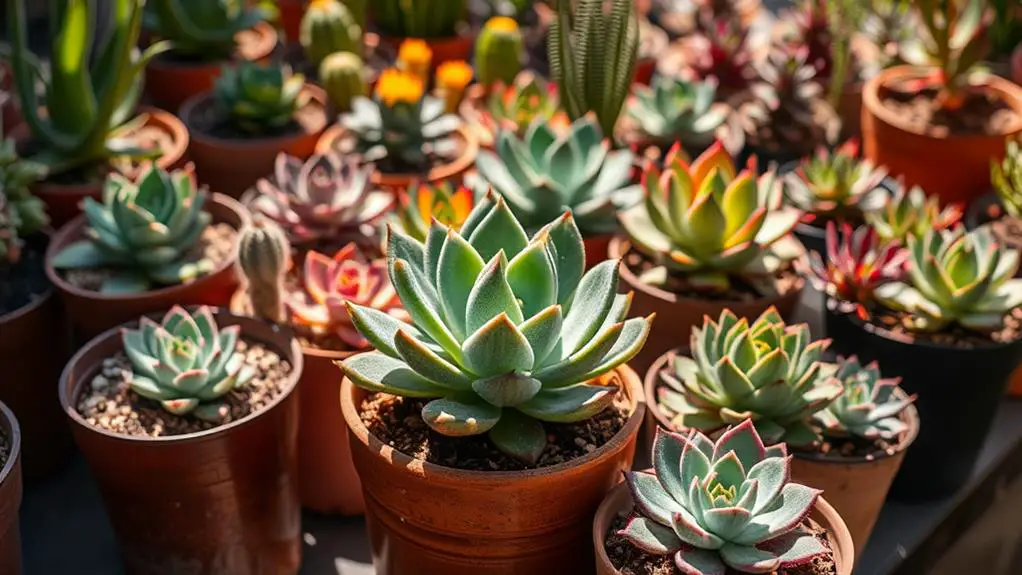
As the seasons change, your succulent care routine needs to adapt to keep your plants healthy.
During winter, most succulents enter a dormant phase and require considerably less water. You might only need to water your succulents once a month because their growth slows down.
In the colder months, it's essential to protect your succulents from freezing temperatures. Consider bringing them indoors or providing adequate insulation if they're outside.
In spring and summer, adjust your watering schedule as temperatures rise. Succulents actively grow during these seasons, so you should water them more frequently, typically every 1-2 weeks, depending on soil moisture.
Also, monitor light conditions closely. While succulents thrive in full sun, too much direct sunlight in the summer can cause sunburn.
Here are some key points to remember:
- Winter Care: Water sparingly, protect from freezing temperatures.
- Spring and Summer Care: Increase watering frequency, watch for signs that they need more water.
- Light and Drainage: Provide full sun but protect from harsh summer rays, guarantee proper drainage.
Monitoring Plant Health
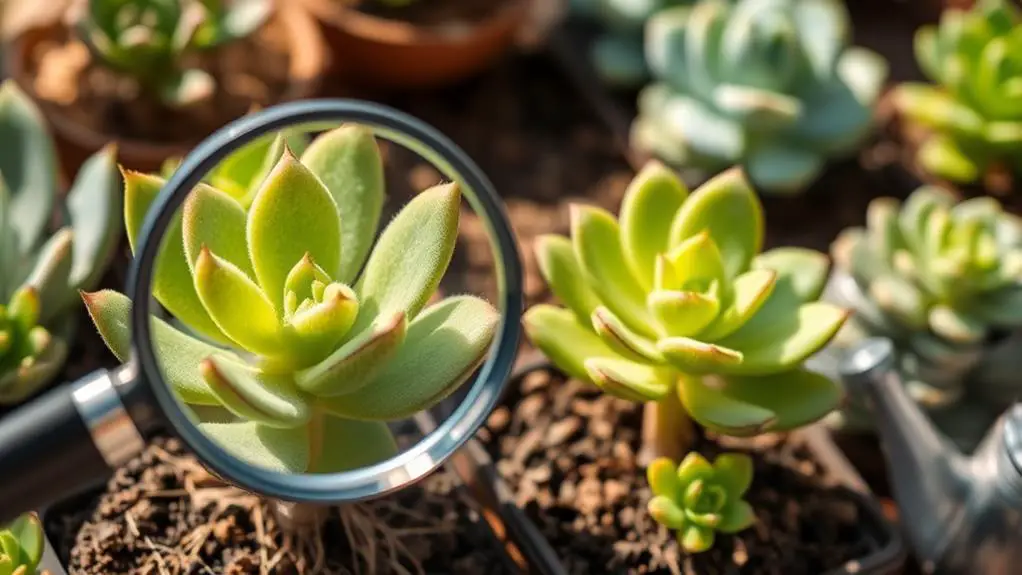
Regular monitoring of your succulents is essential for maintaining their health and vibrancy. Start by inspecting your plants regularly for signs of stress. Yellowing leaves or unusual spots often indicate overwatering or pest issues.
When it comes to watering, check the soil moisture levels by feeling the top 1.25 inches of soil. Only water your succulents when this layer is completely dry to avoid root rot.
It's also important to observe your succulents for signs of adequate light. Upright growth and vibrant color are good indicators. If you notice your succulents' leaves stretching or leaning, they might need more sunlight.
Pest issues are another key aspect of monitoring plant health. Check the undersides of leaves and stems for pests like mealybugs and spider mites. Catching these early can prevent infestations from spreading.
Additionally, keep your plant environment clean by dusting the leaves regularly. Dust can block sunlight and hinder photosynthesis, affecting overall plant health.
Outdoor Care Tips
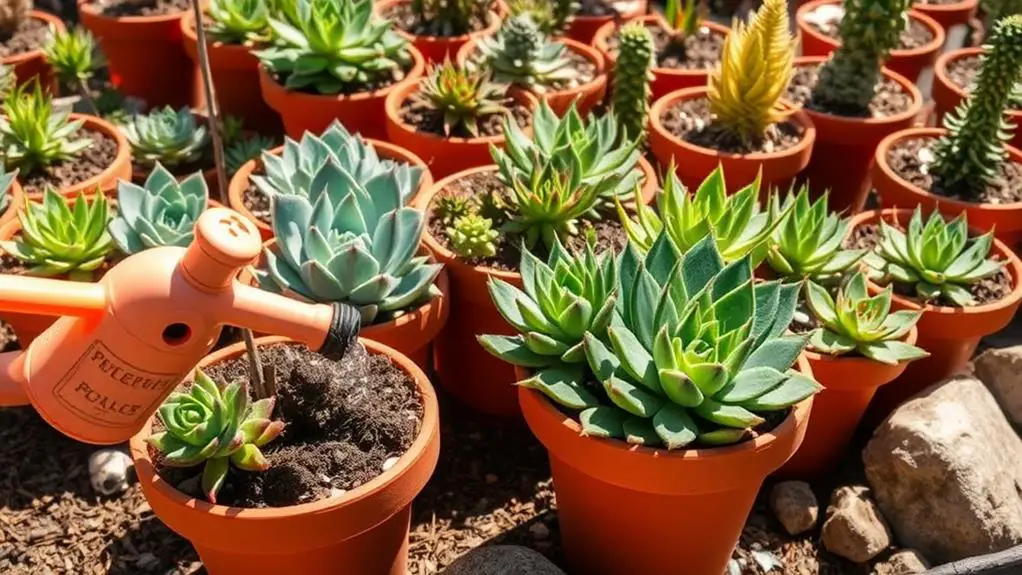
When caring for succulents outdoors, it's important to give them the right amount of light and keep an eye on the temperature.
Make sure they get filtered sunlight to avoid leaf burn, especially during hot days.
Also, protect them from frost by moving them inside or covering them when it gets too cold.
Proper Light Exposure
During the warmer seasons, making sure your outdoor succulents get the right light exposure is essential for their health. Succulents thrive when they receive approximately six hours of bright, indirect sunlight each day.
While full sun might seem appealing, it can actually cause leaf burn and stress your plants. Here's how you can take proper care of your succulents regarding light:
- Provide Filtered Light: During the hottest months, place your succulents in areas with partial shade, especially if they've solid green, pale, or variegated leaves. This helps prevent sunburn.
- Rotate Weekly: To promote even growth and prevent your plants from leaning, rotate your succulents weekly. This makes sure all sides get adequate light exposure, keeping them balanced and healthy.
- Watch for Signs of Insufficient Light: Keep an eye out for elongated stems or plants leaning towards the light source. These signs indicate that your succulents need more brightness. Adjust their placement to make sure they get the light they need.
Optimal Temperature Range**
Your succulent's health heavily depends on maintaining the right temperature range. For best growth, you should keep your succulents in moderate temperatures, ideally between 60°F and 80°F (15°C – 27°C). Sudden temperature fluctuations can stress these plants, so aim for a stable environment to promote their health.
When temperatures drop below freezing, succulents are at risk from frost, which can damage their cell walls. To protect them, consider moving your plants indoors or covering them during cold nights. Additionally, during extremely hot weather, providing some shade will help prevent sunburn, especially for smaller succulents.
| Temperature (°F) | Temperature (°C) | Action Needed |
|---|---|---|
| 60 – 80 | 15 – 27 | Best growth |
| Below Freezing | Below 0 | Protect from frost |
| Extremely Hot | Above 80 | Provide some shade |
| Sudden Changes | Varies | Maintain stable environment |
| Movable Containers | – | Easy relocation |
Using movable containers can be a game-changer. This allows you to relocate your succulents to avoid extreme conditions, ensuring they remain in their best temperature range. By following these tips, you'll help your succulents thrive, keeping them healthy and beautiful.
Frequently Asked Questions
How to Make Your Succulents Thrive?
To make your succulents thrive, give them six hours of bright, indirect sunlight daily. Water only when the soil is dry, use well-draining soil and pots with drainage holes, and fertilize monthly during the active growth season.
What Is the Trick to Keeping Succulents Alive?
To keep succulents alive, water them only when the soil's dry, use well-draining soil, provide 4-6 hours of sunlight daily, choose pots with drainage holes, and fertilize during their growing season. Avoid overwatering and winter feeding.
How Do I Keep My Succulents Happy?
You've got to give your succulents bright, indirect light for 4-6 hours daily. Water only when the soil's dry using the "soak and dry" method. Use well-draining soil, pots with drainage holes, and fertilize during spring and summer.
How to Have Success With Succulents?
You'll achieve success with succulents by ensuring they get bright, indirect sunlight, watering only when soil's dry, using well-draining soil, selecting pots with drainage holes, and fertilizing during their growth season. Follow these steps and thrive!
Conclusion
You've got this! By following these 10 essential tips, your succulents will thrive and bring you joy. Remember to give them plenty of bright, indirect sunlight, water them carefully, and choose the right soil and pots. Keep an eye out for pests and make seasonal adjustments as needed. Don't forget to fertilize during the growing season and regularly check their health. With a little care and attention, your succulents will flourish and brighten up your space.

